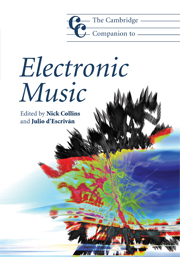Introduction
Published online by Cambridge University Press: 28 September 2011
Summary
Electronic music is the mainstream. From musique concrète to audiovisual sampling, from elektronische musik to minimal techno, from the Telharmonium to the laptop, electrical technology has facilitated more than a century of original music, spawning a multitude of new styles, instruments and methods. Fruitful crossovers with other media and arts have allowed it to reach new audiences and to become an accomplice in many forms of expression. It appears ubiquitous, from mobile phones, television and podcasts to the art gallery and other unorthodox performance spaces. In many ways, electronic music is now so well accepted and integrated into contemporary practice that it is transparent to the observer. Yet on the periphery of musical exploration it remains highly visible – from sonic art, to live electronics, to new advances in computational music.
Whilst electronic music would not restrict itself to computer-mediated art, much current work in this area is related to computational applications and the boom in accessibility of home computers. The last sixty years have seen a move from rare electronic music studios to the ubiquity of bedroom studios. As if the thought experiment about Shakespearian monkeys has come true, millions of composers are at large exploring a multiplicity of software and devices in the pursuit of their own musical worlds. The entry cost of an electronic music hobby is no longer the hard graft of acoustic instrument practice, but a simple willingness to explore musical outputs within predominantly visual software paradigms. The influence of computers in compositional techniques, sound analysis and processing, performance interfaces and concert practice is astounding.
- Type
- Chapter
- Information
- The Cambridge Companion to Electronic Music , pp. 1 - 4Publisher: Cambridge University PressPrint publication year: 2007
- 1
- Cited by

